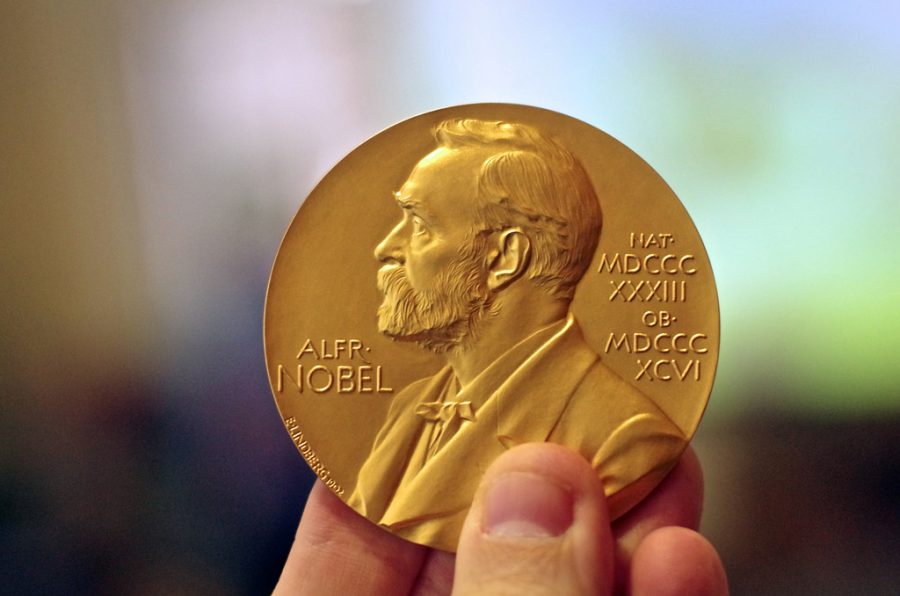A Nobel Prize of Noble Potential
One-thousandth the width of a single strand of human hair: the size of nanomachines developed by this year’s winners of the Nobel Prize in Chemistry. These nanomachines could be the vessel needed for the discovery of the cure for cancer.
On October 5, scientists Jean-Pierre Sauvage, J. Fraser Stoddart, and Bernard L. Feringa won the prize for their work on the development of molecular machines. Creating structures on the scale of a nanometer (one-billionth of a meter), these three scientists built upon each other’s research, developing the foundation for nanotechnology.
The first step towards molecular machines was Dr. Sauvage’s synthesis of interlocking ring-shaped molecules. To do so, Sauvage found that a copper ion could be used like a pin; the rings would form around this pin, and the copper ion could then be removed to create the interlocking rings. These ring molecules, known as catenanes, were held together mechanically, like the links in a chain, rather than with chemical bonds as usual.
Dr. Stoddart continued this research in the field of nanotechnology. Instead of interlocking rings, Stoddart and his colleagues synthesized a ring molecule shaped around a dumbbell-shaped axle, known as a rotaxane. The mechanics are very similar to a ring on an abacus, but extremely tinier in proportions.
From this, Stoddart went on to construct more complex devices using these rotaxanes. He began by creating a computer chip that resembled a molecular abacus. As he progressed in his research, he developed a sort of molecular elevator using three of the dumbbell-and-ring molecules standing parallel to one another. The ring molecules were connected to form a platform that could rise up to 0.7 billionths of a nanometer. He also found that roxatanes bending thin gold foils acted like a tiny mechanical muscle.
In 1999, Dr. Feringa is responsible created the world’s first synthetic molecular motor. This miniscule rotor, capable of unidirectional 360° rotation was powered by light and consisted of a bis-helicene connected by an alkene double bond displaying axial chirality and having two stereocenters. Essentially, the light energy powers the rotation of the molecule; one rotation occurs through a series of 4 reactions.
This first motor was not exceptionally fast, but fifteen years later, Feringa and his research were able to synthesize a motor capable of spinning 12 million times per second. The team also built a four wheel drive molecular “nanocar.” This nanocar consisted of four motors that acted as wheels and were connected by a nano-chassis.
The contributions of these three men to the development of nanotechnology is fascinating, but they are just the foundation of this ever-advancing science. “They’ve got it started,” commented Donna J. Nelson, the president of the American Chemical Society. “This is just the beginning.”
There are a myriad of natural molecular machines in living organisms that transport cell material, construct proteins, and divide cells. The synthesized molecular machines are much more primitive and not nearly as complex as the ones found in nature, but scientists are optimistic about the future advancement of nanotechnology.
Dr. Feringa told journalists, “Think about nanomachines, microrobots. Think about tiny robots that the doctor in the future will inject in your blood veins, and they go search for cancer cells or going to deliver drugs, for instance.” He also mentioned that this technology could lead to the construction of “smart materials” that alter their properties based on external stimuli.
The research by the three Nobel Prize winners is a step in the right direction towards the cure for cancer as well as for the treatment of many other diseases. Nanotechnology is seeing increasing innovation, and there is no limit for the discoveries that are yet to come.

Shalom le'kulam, my name is Jonathan Flat and I am the Managing Editor for this outstanding school newspaper. As a 16-year-old in the 12th grade, I'll...









Jake Werner • Nov 2, 2016 at 12:36 pm
Great article! It is amazing what people are creating and innovating!